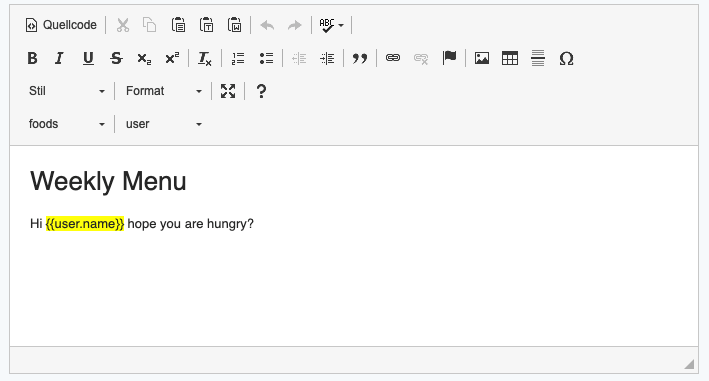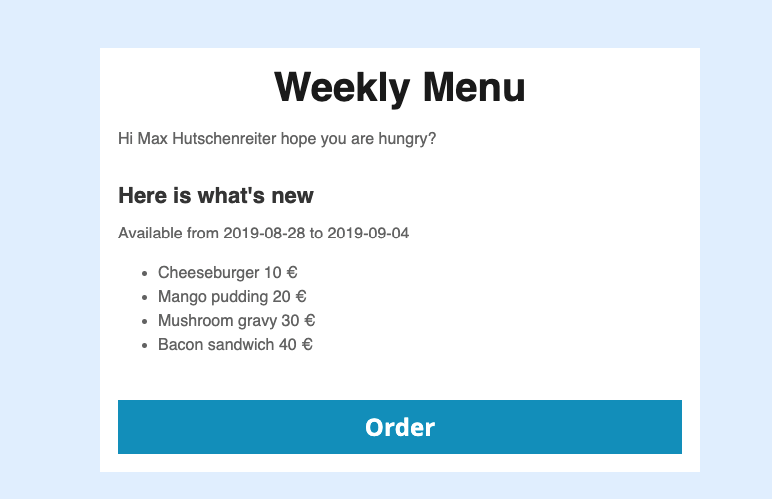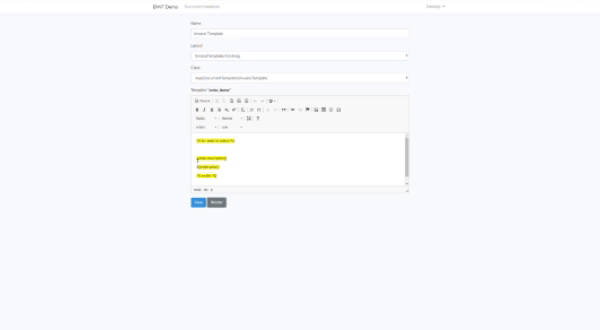Document templates Laravel package is intended for creating/managing user editable document templates, with ability to add placeholders, and fill them from various data sources (models, collections, arrays, objects). The package uses Twig as a main template engine, but it is possible to extend it with other template engines. Document templates can be used as a base for creating editable pdf documents such as invoices, reports etc., for email templates or any other editable, server generated documents. The user editable parts of the document template are secured using Twig Sandbox Extension. The sandbox behaviour can be configured in the config file. This package is part of the Business Workflow Framework. For a quick introduction on how to use the package please see this blog post.
- Laravel 9 or newer
- php 8+
- Laravel 9 or 10
- php 8+
- Laravel 5.7 or newer
- php 7.4+
- Laravel 5.7 or newer
- php 7.3+
Install with composer
composer require 42coders/document-templates Publish the migrations, views, vue components and config:
php artisan vendor:publish --provider="BWF\DocumentTemplates\DocumentTemplatesServiceProvider"There are separate publish groups if you don't need all the vendor files in your application. To publish only one group use the following command
php artisan vendor:publish --provider="BWF\DocumentTemplates\DocumentTemplatesServiceProvider --tag=group_name".The following file groups are available for publishing:
- migrations publishes the migration files to the database directory
- views publishes the views for the basic administration of the document templates to the
resources/views/vendor/document-templates - components publishes the views for the basic administration of the document templates to the
resources/js/vendor/document-templates/components - config publishes the configuration file to the config directory
- ckeditor publishes the ckeditor and the placeholders plugin for the ckeditor into the
public/vendor/document-templates/js/lib/ckeditorandresources/js/vendor/document-templates/js/ckeditorrespectively - js publishes the javascript for easier initialization of the administration gui
DANGER ZONE
If you already published the files and want to overwrite them use the: --force argument.
This command overwrites your changes in the published files, use it carefully.
Run the migration
php artisan migrateAdd the routes from the package to your routes file:
\BWF\DocumentTemplates\DocumentTemplates::routes(YourExtendedDocumentTemplatesController::class);The routes function accepts 1 argument:
- Controller class name to use with the routes
This trait is responsible for reading the layout files, handling the datasources and rendering the document with data. Can be applied to any class with the convention that the class has only optional parameters in the constructor. These classes represent the document types, create separate classes for Invoices, Letters, Registration Emails etc.
The model responsible to store the document templates, the default table is: document_templates.
Editable template is the dynamic part in the layout that the user can modify.
The layouts are twig template files created by the developer, they can be used by document templates.
The default controller for administration of the document templates.
Placeholders are twig template variables or expressions used in the editable templates to be replaced during the rendering, e.g. {{user.name}} or {% for user in users %}
Data sources are the objects that provide data to the document template, and replace the placeholders with actual data in the rendering process. Data sources can be created from Models, Objects, arrays, or from any scalar types (strings, integers).
The configuration can be found in config/document_templates.
layout_path - path to the layout files, defaults to: resources/templates.
The twig sandbox can be configured with the settings below, read more about sandbox configuration here. The extended sandbox policy class adds support for allowing all object properties by setting wildcard * in the first position in the allowed properties array.
'template_sandbox' => [
'allowedTags' => ['for'],
'allowedFilters' => ['escape'],
'allowedMethods' => [],
'allowedProperties' => ['*'],
'allowedFunctions' => []
]Twig environment options can be configured with the settings below, read more about the options here.
'twig' => [
'environment' => [
'debug' => false,
'charset' => 'utf-8',
'base_template_class' => '\Twig\Template',
'cache' => false,
'auto_reload' => false,
'strict_variables' => false,
'autoescape' => false,
'optimizations' => -1
]
]Twig extensions can be loaded over twig.extensions by adding the extension's class to the array (which extends \Twig\Extension\AbstractExtension or implements \Twig\Extension\ExtensionInterface).
'twig' => [
'extensions' => []
]The model class to be used with route model binding, and in the DocumentTemplatesController
'model_class' => \BWF\DocumentTemplates\DocumentTemplates\DocumentTemplateModel::class,Base url to use for generating the routes with DocumentTemplate::routes() (e.g /document-templates/, /document-templates/1/edit).
These routes are also named by this base url, and they look like this: route('document-template.index')
'base_url' => 'document-templates'Configure if the package should load it's default routes
'load_default_routes' => falseCreate a layout file in the configured layout path, the layout files should have .twig extension. The editable parts in the layout should be defined as blocks in the layout:
<!DOCTYPE html>
<html lang="en">
<head>
<meta charset="UTF-8">
<title>
{% block title %}
{% endblock %}
</title>
</head>
<body>
{% block content %}
{% endblock %}
</body>
</html>The name of the block is used as the name of the editable template.
Document Template class can be any class which is uses the DocumentTemplate trait and implements the DocumentTemplateInterface. When using the trait the dataSources method should be implemented, it defines the data used by the document.
The following example show the datasources method:
class DemoDocumentTemplate implements DocumentTemplateInterface
{
use DocumentTemplate;
protected function dataSources()
{
return [
$this->dataSource($userModelInstance, 'user', true, 'users'),
$this->dataSource($orderAssociativeArray, 'order', true, 'orders'),
$this->dataSource($anyObject, 'test'),
$this->dataSource('', 'text'),
$this->dataSource(0, 'number'),
];
}
}The dataSource method accepts 4 arguments:
$data- instance of the data to use, it can be an empty instance, it is used to be able to show the possible placeholders when editing the document template in the admin area.$name- defines the namespace for the data object e.g. $name = 'user'. The placeholders will be prefixed with the name:{{user.name}}. When using scalar data sources, the namespace is mandatory, for arrays and objects it can be omitted.$isIterable- defines if the datasource can be used in a for loop in the template$iterableName- defines the name of the iterable variable, which should be used in the template e.g. $iterableName = 'users' the placeholder for iteration would be{% for user in users %}
The signature if the dataSource method can be found below:
protected function dataSource($data, $name = '', $isIterable = false, $iterableName = '')
Laravel models can act as a data source for the document templates by using the ModelProvidesTemplateData trait and implementing the TemplateDataSourceInterface. The developer can define which fields can be used as a template placeholder by overriding the getTemplateFields method. Example model used as a data source, allowing the fillable attributes as placeholders:
class User implements TemplateDataSourceInterface
{
use ModelProvidesTemplateData;
/**
* The attributes that are mass assignable.
*
* @var array
*/
protected $fillable = [
'name', 'email'
];
protected function getTemplateFields()
{
return $this->fillable;
}
}The document template class can be instantiated with the DocumentTemplateFactory. The build method accepts one argument: the DocumentTemplateModel.
$documentTemplateModel = DemoDocumentTemplateModel::findOrFail($id);
$documentTemplate = DocumentTemplateFactory::build($documentTemplateModel);Or the document template can be instantiated manually, in this case the init() method should be used to initialize the document template (it creates the document template by retrieving the first row from the database with the given document template class).
Use the addTemplateData method to add the data which should replace the placeholders in the document. The arguments for the method are:
$data- the data object or collection of data sources e.g.User::all(), assuming theUsermodel is implementing theTemplateDataSourceInterface$name- The namespace used in the template, it should be the same as defined indataSourcesmethod of theDocumentTemplateclass.
The render method is used to render the document with the given data, returns the rendered document as string.
$documentTemplate = new DemoDocumentTemplate();
$documentTemplate->init();
$documentTemplate->addTemplateData(User::all(), 'users');
$documentTemplate->addTemplateData($ordersCollection, 'orders');
$documentTemplate->addTemplateData($testObject, 'test');
$documentTemplate->addTemplateData(42, 'number');
$documentTemplate->addTemplateData('coders', 'text');
echo $documentTemplate->render();The need for pdf generation is a quite common thing in web development. The package support pdf generation
with dompdf, (using laravel-dompdf package)
and pupeteeer (using spatie/browsershot package).
The document template data should be set up the same way like for the simple rendering (see the previous section: Rendering template with data), but instead of the render method you should use the renderPdf method:
$pdf = $documentTemplate->renderPdf(storage_path( 'app/my_example.pdf'));The only argument of the method is the desired path and file name, and it returns the path of the generated file.
The package supports multiple pdf renderers, the desired pdf renderer can be set up in the config/document-templates.php:
DomPdf:
'pdf_renderer' => \BWF\DocumentTemplates\Renderers\DomPdfRenderer::classIf you would like to configure the dompdf package, publish the dompdf configuration with:
php artisan vendor:publish --provider="Barryvdh\DomPDF\ServiceProvider"When published, the config file can be found in config/dompdf.php.
For more details about the dompdf configuration please check the laravel-dompdf documentation.
Browsershot:
'pdf_renderer' => \BWF\DocumentTemplates\Renderers\BrowsershotPdfRenderer::classThe browsershot package requires node 7.6.0 or higher and the Puppeteer Node library.
On MacOS you can install Puppeteer in your project via NPM:
npm install puppeteer
Or you could opt to just install it globally
npm install puppeteer --global
On a Forge provisioned Ubuntu 16.04 server you can install the latest stable version of Chrome like this:
curl -sL https://deb.nodesource.com/setup_8.x | sudo -E bash -
sudo apt-get install -y nodejs gconf-service libasound2 libatk1.0-0 libc6 libcairo2 libcups2 libdbus-1-3 libexpat1 libfontconfig1 libgcc1 libgconf-2-4 libgdk-pixbuf2.0-0 libglib2.0-0 libgtk-3-0 libnspr4 libpango-1.0-0 libpangocairo-1.0-0 libstdc++6 libx11-6 libx11-xcb1 libxcb1 libxcomposite1 libxcursor1 libxdamage1 libxext6 libxfixes3 libxi6 libxrandr2 libxrender1 libxss1 libxtst6 ca-certificates fonts-liberation libappindicator1 libnss3 lsb-release xdg-utils wget
sudo npm install --global --unsafe-perm puppeteer
sudo chmod -R o+rx /usr/lib/node_modules/puppeteer/.local-chromium
For more details please check the browsershot documentation.
This package includes Vue component and a resource controller as a starting point for the document template admin implementation. In order to use the components you have to use the Vue JavaScript framework. The component is published to resources/js/components/document-templates. Register the component in your application (app.js):
Vue.component('document-template-form', require('./vendor/document-templates/components/DocumentTemplateFormComponent.vue').default);Please note that the pats may vary depending on your application's directory structure.
The admin form component uses CKEditor for the user editable templates. The package ships with a custom built placeholders plugin for CKEditor. The placeholders plugin displays the placeholders as select boxes, every dataSource has it's own select box. The selected placeholders are automatically inserted into the editor's content as CKEditor inline widgets. The placeholder widgets can be moved across the text, and can be removed, but theirs content is read only to prevent rendering problems caused by incorrect/modified placeholders.
The CKEditor initialization using the placeholders plugin can be found below:
CKEDITOR.replace(editorId, {
customConfig: '',
extraPlugins: 'richcombo,placeholder_select',
toolbarGroups:[
{ name: 'basicstyles' },
'/',
{ name: 'placeholder_select'}
],
placeholder_select: {
placeholders: _this.placeholders,
}
});If you'd like to require/initialize all the necessary javascript automatically, you can use the document-template.js to do so.
Add the following to the app.js:
require('./vendor/document-templates/js/document-templates');It includes the ckeditor, the placeholder plugin for ckeditor, sets the ckeditor base path, and registers the Vue component.
The package ships with a default controller for your convenience, to be able to quickly scaffold an administration interface for the package.
You could extend the DocumentTemplatesController, and define the available document template classes, like below:
class DemoDocumentTemplatesController extends DocumentTemplatesController
{
protected $documentClasses = [
DemoDocumentTemplate::class,
DemoDocumentTemplate2::class
];
}These classes appear on the create/edit form for the document, every class should correspond to a document type (e.g. create separate classes for Invoices, Letters, Registration Emails etc.).
If you need to change the default behaviour of the controller feel free to skip the extension and implement the necessary methods yourself.
In this case you can still use the ManagesDocumentTemplates trait which contains the methods to get the data for the api endpoints used by the vue components,
those endpoints are: /placeholders and /templates. If you use the trait you should implement the actions for these endpoints.
Demo application can be found here: https://github.com/42coders/bwf-demo. You can use a symlinked version of the document templates package in the composer.json:
"repositories": [
{
"type": "path",
"url": "../document-templates",
"options": {
"symlink": true
}
}
],As you can see from the repository configuration, the package should be cloned in the same directory as the demo app. Also the demo app requires app.js directly from the package 'require('./../../vendor/42coders/document-templates/resources/js/app');', this allows you to develop the package and check the changes in the demo app immediately, without the need for composer install, and vendor:publish.
Every contribution is welcome. We should use the usual GitFlow like workflow: create branches for features and bug fixes, when the development has been finished create a pull request to the develop and it will be reviewed by other developer, and merged/commented/declined accordingly.
It is important to create unit tests for all new features developed, and also for all bug fixes to keep the package stable and easy to use.
For the new features it is recommended to add a demo of the feature to the demo application and extend the documentation as well.
The php tests are using PHPUnit, to run the test you can use either vendor/bin/phpunit or composer test command.
Test code coverage can be generated with composer test-coverage command. In order to generate coverage it is necessary to have Xdebug extension installed and enabled for php cli. The code coverage html report can be found in the tests/coverage directory.
Javascript tests are using Jasmine test framework. Run the javascript test with the following command npm run test
Api documentation can be generated with phpDox. To download and install phpDox please follow the instructions here. Once the phpDox is installed generate the api documentation by running composer build-docs. When the process is finished the documentation can be found in docs/html directory.
The Document Templates is free software licensed under the MIT license.





